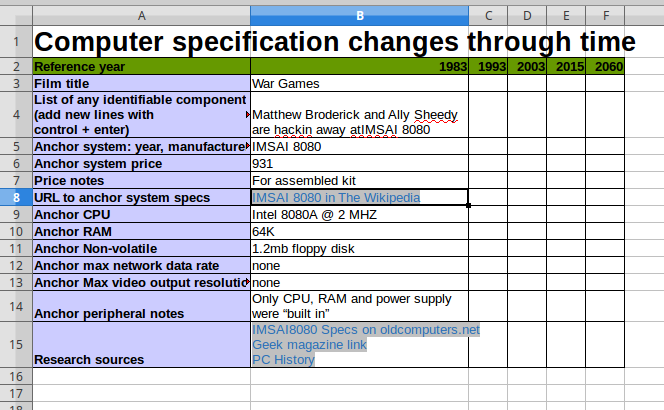| course | mod | topic | first name | date completed |
|---|---|---|---|---|
| cit-115 | wk. 3 | Is newer better? | ||
| module learning objectives | ||||
|
||||
Is newer better?
The "Change and Remain" project
Original telephones manufactured by AT&T were designed to last for decades. Modern electronics is far more multi-purposed, and often designated as at end-of-life in 5 years or less.
The newer-is-better notion is very lucrative, indeed, and has driven the development of consumer electronic capabilities many predicted were physically impossible to produce at the scale of global commofification.
War Games (1983) and Jurassic Park (1993) Tech Comparison
After watching the two film clips twice, populate the following table with facts about the capabilities and characteristics of the computers shown in the clips
War Games (1983)  |
Jurassic Park (1993)  |
|---|---|
| Describe: Computer display, user interface, computational power, communication systems, "speed" | Describe: Computer display, user interface, computational power, communication systems, "speed" |
Generate component evolution data
Create a spreadsheet that allows you to support a legitimate answer to the core question in this module, namely: When is buying newer computer components advantageous to improve overall performance?
Your spreadsheet should probably have at least this set of columns plus additional ones to support your core calculations (such as adding a column for storing units of some measurement separate from its value: store "100" in a column separate from "mhz").
You should try creating this spreadsheet from scratch. Use an internet search engine to help you format cells in libre office sheets or excel and insert basic formulas to calculate cost per cycle, etc.
Heart of the matter: What should we upgrade?
Choose a computing environment and make the case to the system design committee about which components should be optimized for your general use case and which can remain static as they were in year ***INSERT BENCHMARK YEAR***.
Use quantitative figures (numbers) you generated and specific device models to make your case. Feel free to make a table or chart or fancy list.
Submitting
Use a computer or paper/pencil. Please include a paper copy of your work in your folder.
Choose your context (or better yet, compare two!)
- A pure science microbiology research laboratory
- An e-commerce business like TruTech tools which sells quality HVAC diagnostic gear
- A university like CCAC buying boxes for a general computer lab
- An approved field of your interest
Extension ideas
- Create a graph in your spreadsheet of choice depicting the change in price per computing cycle of your chosen models
- Turn your graph into a graphic and use it in an infographic creator program online
- Compute the size of room needed if one were filling it completely with IMSAI 8080 boxes to roughly equal the compute power of a modern hand-held computer of your choice. Document your calculations and visualize your result creatively so we can share it!
caseyfleser.jpg)
